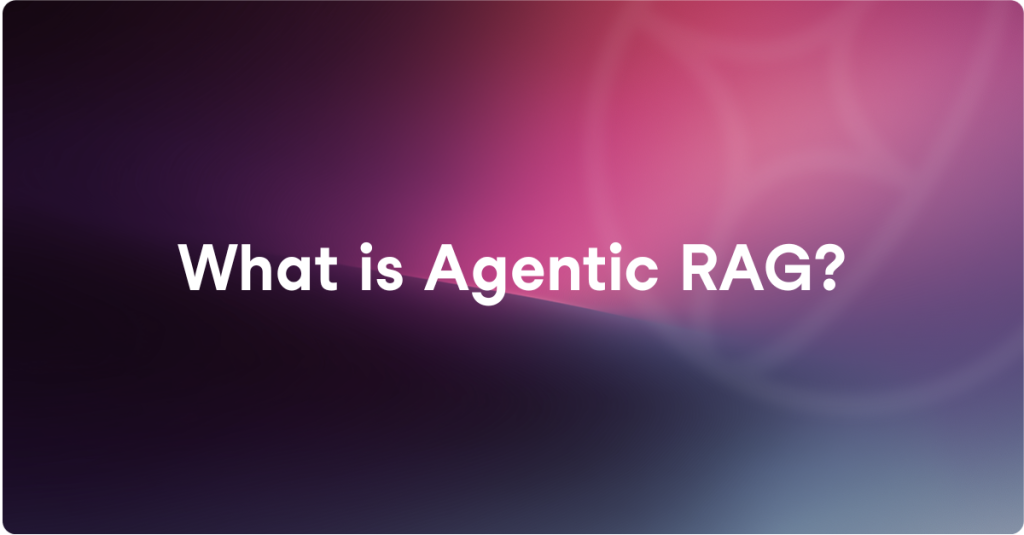What is Agentic RAG?
Retrieval-Augmented Generation (RAG) is a way to make AI answers more reliable by letting the system look things up before it responds. Instead of relying only on what the model has memorized, RAG connects it to external sources of knowledge such as company documents, databases, or the web.
Agentic RAG builds on RAG by giving the system a layer of agency. Instead of fetching context once and answering, the model can plan its next move, decide what to retrieve, and improve its own output before it responds.

Key capabilities of agentic RAG
Here’s what makes it different from traditional RAG:
- Iterative process: The system can loop between searching and reasoning, gathering information in stages until the answer feels complete.
- Autonomy: It can choose the best next move—whether that means running another search, using a different source, or applying a tool.
- Self-checking: Before finalizing, it can critique its draft answer against the evidence and improve it if needed.
The result is an AI that doesn’t just retrieve knowledge but actively manages the process of finding, validating, and refining information.
Benefits of Agentic RAG
The value of Agentic RAG lies in how it improves the quality and reliability of AI answers.
- Accuracy: By checking and refining its own work, Agentic RAG reduces the risk of AI “hallucinations” and grounds responses in real evidence.
- Adaptability: It can manage more than simple lookups, handling layered or multi-step questions that require pulling together information from different places.
- Up to date information: Instead of being limited to static knowledge, it can bring in new sources, like the web or updated internal documents, when needed.
- Business resilience: In areas where misinformation carries high risk, such as compliance, legal, or customer communication, Agentic RAG improves the reliability and consistency of responses.
Agentic RAG examples
The real strength of Agentic RAG shows up in practice. Here are some concrete ways it can improve how organizations work with information.
- Customer support: An AI assistant can pull details from manuals, policy documents, and past tickets to provide consistent answers. By checking its draft against multiple sources, it reduces the risk of giving customers outdated or incomplete information.
- Knowledge management: Large organizations often have knowledge scattered across wikis, intranets, and shared drives. Agentic RAG can pull these pieces together into clear, reliable answers, reducing the chances of outdated or conflicting information getting through.
- Research and insights: Analysts can use Agentic RAG to combine internal reports with external data, such as market research or news articles. The system can validate its summaries, giving teams more confidence in the insights they use to make decisions.
- Compliance and legal teams: When questions involve regulations or company policies, Agentic RAG can reference the relevant documents directly. This lowers the risk of oversight and increases confidence in the information being shared.
Practical considerations
Agentic RAG offers important advantages, but it also comes with trade-offs to keep in mind:
- Costs and latency: Because the system retrieves and reasons in multiple steps, it often requires more computing power and time than standard RAG. This can mean higher costs and longer response times, which may not be suitable for every situation.
- Guardrails: With more autonomy comes the need for oversight. Setting limits on the number of retrieval steps, monitoring the quality of outputs, and defining clear stop conditions are important to keep the system efficient and reliable.
The AI Computer approach to retrieval
At Maisa, we approach retrieval differently with the KPU, our AI Computer. Instead of relying on repeated retrieval loops, the AI Computer uses a memory-like system that continuously organizes and feeds knowledge as the model works. This allows it to prioritize information step by step and keep context coherent throughout long and complex tasks.
Enterprise automation requires AI that is traceable, reliable, and capable of handling extended workflows. By making retrieval part of its memory rather than an add-on, the AI Computer is designed to meet that need.
